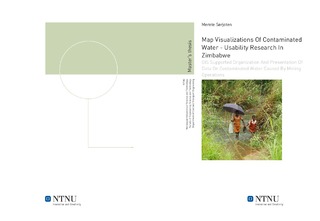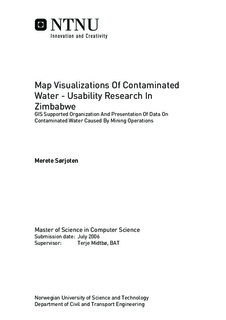| dc.contributor.advisor | Midtbø, Terje | nb_NO |
| dc.contributor.author | Sørjoten, Merete | nb_NO |
| dc.date.accessioned | 2014-12-19T13:39:46Z | |
| dc.date.available | 2014-12-19T13:39:46Z | |
| dc.date.created | 2013-08-12 | nb_NO |
| dc.date.issued | 2006 | nb_NO |
| dc.identifier | 640167 | nb_NO |
| dc.identifier | ntnudaim:1363 | nb_NO |
| dc.identifier.uri | http://hdl.handle.net/11250/253196 | |
| dc.description.abstract | The aim of this project was to find a method for organization and visualization of water contamination in a mining area north of Harare in Zimbabwe. This was important because it does not exist a synopsis that gives a good picture of the situation of contamination in the area. There is many people living there, and they are dependent on water to survive. Some measurement data from the ground water and from the river flowing through the area has been taken earlier. Those measurement data were not organized, and one could only find them in books and bindings at the mine. Existing measurement data and new measurement data, taken during the fieldwork, were organized into a database. The database was used for subsequent work in a geographic information system.One wanted to make a map to the local inhabitant that illustrated the water quality along the river. The inhabitants were not used to read and interpret maps, and a survey were carried out about map interpretation and understanding. The locals were asked about symbols and colours they preferred for presentation of symbols and features in the area. They were exposed to four different maps over the mine area. The purpose of this was to find a map that the locals preferred for presentation of water quality. A simple and easy to understand map, with only the most important features were the most appropriate for the respondents of the survey.It did not exist a map basis of the area. One had to employ creative methods to form a map basis. MicroStation V8 was used to create layers of topographic features from the area. Those layers were imported into ArcMap, and used to make a map to the local inhabitants. The map illustrated dangerous and safe areas along the river for drinking water. The map basis and the database over water quality measurements were implemented into ArcMap as a feasibility study to a geographic information system. A geographic information system (GIS) was seen as essential for analysis and visualization of contamination in the area. This project illustrated some of the possibilities of a GIS, but there is still much work for development of the system. The target is to make use of a GIS for mapping of contamination of all areas in Zimbabwe. That is feasible if one is able to implement good structure for database management and find a good map basis for the country. | nb_NO |
| dc.language | eng | nb_NO |
| dc.publisher | Institutt for bygg, anlegg og transport | nb_NO |
| dc.title | Map Visualizations Of Contaminated Water - Usability Research In Zimbabwe: GIS Supported Organization And Presentation Of Data On Contaminated Water Caused By Mining Operations | nb_NO |
| dc.type | Master thesis | nb_NO |
| dc.source.pagenumber | 109 | nb_NO |
| dc.contributor.department | Norges teknisk-naturvitenskapelige universitet, Fakultet for informasjonsteknologi, matematikk og elektroteknikk, Institutt for datateknikk og informasjonsvitenskap | nb_NO |

